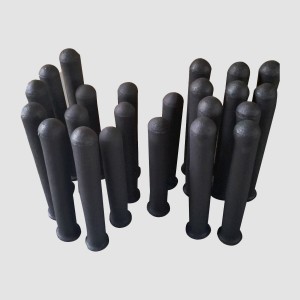-

Thermocouple Protection Sleeve Graphite Silicon Carbide
Thermocouple protection sleeves are commonly used in metal melting applications, where high temperatures and harsh environments can quickly damage or destroy the thermocouple sensor. The protection sleeve serves as a barrier between the molten metal and the thermocouple, which allows accurate temperature readings without risking damage to the sensor.
In metal melting applications, the materials of thermocouple protection sleeves can withstand extreme heat and chemical exposure. They are used in a variety of industries, like foundries, steel mills, and metal fabrication plants. Proper use thermocouple protection sleeves can help improve process control and product quality, as well as reduce maintenance costs associated with sensor replacement.
-

Silicon nitride thermocouple protection tube Si3N4
Silicon nitride ceramics have become the preferred material for protecting the external heaters in the aluminum processing industry due to their excellent high-temperature performance and corrosion resistance.
-

Heating Protection Sleeve Tube Si3N4
The immersion-type heating protection sleeve tube is primarily used for aluminum alloy casting, hot-dip galvanizing, or other non-ferrous metal liquid treatments. It provides efficient and energy-saving immersion heating while ensuring the optimal treatment temperature for non-ferrous metal liquids. Suitable for non-ferrous metals with temperatures not exceeding 1000℃, such as zinc or aluminum.
-

Tundish to Mould Shrouding Ladle shroud
The ultimate shield for continuous steel casting—our ladle shroud, made from premium graphite and alumina, offers unmatched durability, thermal stability, and protection. Experience precision and performance that keeps production moving efficiently and effectively.
-

High Performance Sub entry nozzle In Continuous Steel Casting Process
The sub entry nozzle is essential for maintaining controlled metal flow during casting processes, especially in high-precision steel manufacturing. Designed for durability and thermal resistance, this nozzle ensures reliable flow control and minimizes turbulence, supporting a clean, uninterrupted casting process.
-

Tundish Nozzle & Submerged Entry Shroud
Sub Entry Shroud is a high performance refractory tube manufactured by isostatic pressure process, designed for the flow control of molten steel from tundish to crystallizer, and is widely used in the continuous casting process in the steel industry.
-

Tundish Shroud & Tundish Nozzle for Continuous Casting of Steel
A Tundish Shroud is a crucial protective device used in the continuous casting process. It serves to prevent molten metal from splashing and oxidizing as it transitions from the ladle to the tundish. Are you aware of the significant benefits a Tundish Shroud can bring to your steel casting operations?
-

Graphite Degassing Rotor for Aluminum Refining
The graphite degassing rotor is designed for the effective removal of hydrogen and other impurities from molten aluminum, ensuring product purity and quality in die casting and continuous casting processes. With its high wear resistance, anti-oxidation properties, and exceptional durability, our graphite degassing rotor stands out as a reliable, cost-effective choice.
-

Degassing tablets for aluminium degassing machine
Our integrated Degassing tablet for aluminium delivers superior durability against wear and excellent oxidation resistance, providing an economical and reliable option for degassing applications.
-

Side Well Type Aluminium Scrap Melting Furnace for Aluminum chips
The twin-chamber side-well furnace represents a breakthrough solution that enhances efficiency, reduces environmental impact, and simplifies aluminum melting operations. Its efficient design helps factories produce more while staying eco-friendly.
-

Customizable 500kg Cast iron melting furance
Induction heating technology originates from Faraday’s electromagnetic induction phenomenon—where alternating currents generate eddy currents within conductors, enabling highly efficient heating. From the world’s first induction melting furnace (slotted core furnace) developed in Sweden in 1890 to the breakthrough closed-core furnace invented in the U.S. in 1916, this technology has evolved over a century of innovation. China introduced induction heat treatment from the former Soviet Union in 1956. Today, our company integrates global expertise to launch the next-generation high-frequency induction heating system, setting new benchmarks for industrial heating.
-

Gold Crucible For Melting Gold Bars
Gold crucibles are engineered to meet the specific needs of high-temperature metal melting, making them an essential tool for anyone working with precious metals. Whether you’re refining gold, casting, or using crucibles in research and industrial applications, these crucibles provide unmatched performance in terms of durability and heat resistance.

- Email Support info@futmetal.com
- Call Support +86-15726878155